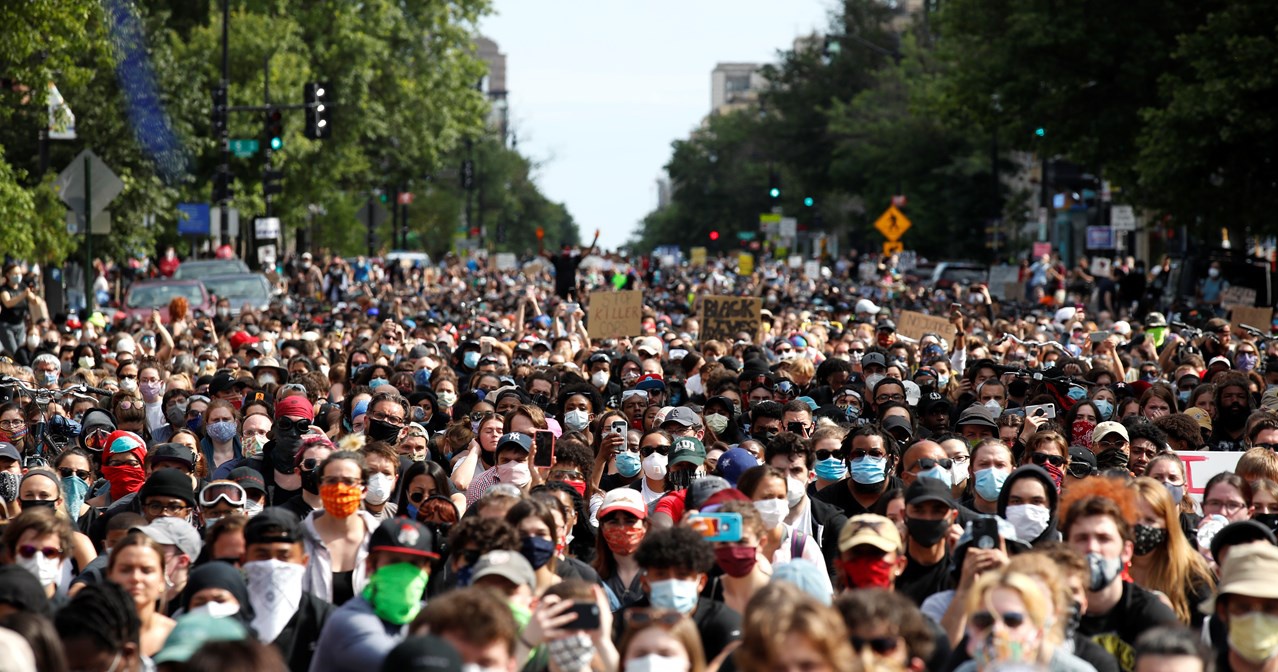The killing of George Floyd on May 25 triggered a wave of protests across the United States. Continued protests demanding dignity and safety for Black lives in the U.S. have inspired demonstrations of solidarity across the globe. Structural violence exemplified by the uninterrupted killing of Black people and unrestrained police belligerence demand systemic solutions to counteract centuries of racial disparities and injustice.
By Raza Rumi[i]
“…social justice and progress are the absolute guarantors of riot prevention. There is no other answer. Constructive social change will bring certain tranquility; evasions will merely encourage turmoil.”—Martin Luther King, Jr.
The world’s richest and most powerful country has been struggling to cope with a host of crises: a deadly pandemic that has killed more than 122,000 Americans and infected more than 2 million; an economic downturn that has rendered millions unemployed; and now uprisings and violence on the streets. All three are interlinked, but the latter is not a new development. Race-based violence is as old as America itself.
In early June, the renowned think tank International Crisis Group, which reports primarily on wars and conflicts, in its first ever report on the U.S., criticized its government for “enflaming and courting conflict.”[ii] The ICG highlighted the woes of thousands rightfully protesting against racial injustice and state-sanctioned police brutality, while warning the government against deepening injustice by waging battle against its own people based on color. “Over the long term, the nation will need to take steps to end the police’s brutality and militarization as well as structural racial inequality if it wants to avoid similar future crises,” the ICG report added. [iii]
George Floyd’s Killing and Countrywide Uprisings
On May 25 of this year, George Floyd, a Black man in Minneapolis, was brutally murdered by the police. The video of his murder shook the nation, especially because the digital age amplifies the impact of such violence. The unarmed and handcuffed 46-year-old victim had a policeman’s knee pressed into the back of his neck for 8 minutes and 46 seconds, despite him repeatedly pleading, and bystanders echoing, that he couldn’t breathe. The police officer’s inhumane maltreatment was excessive and patently illegal.
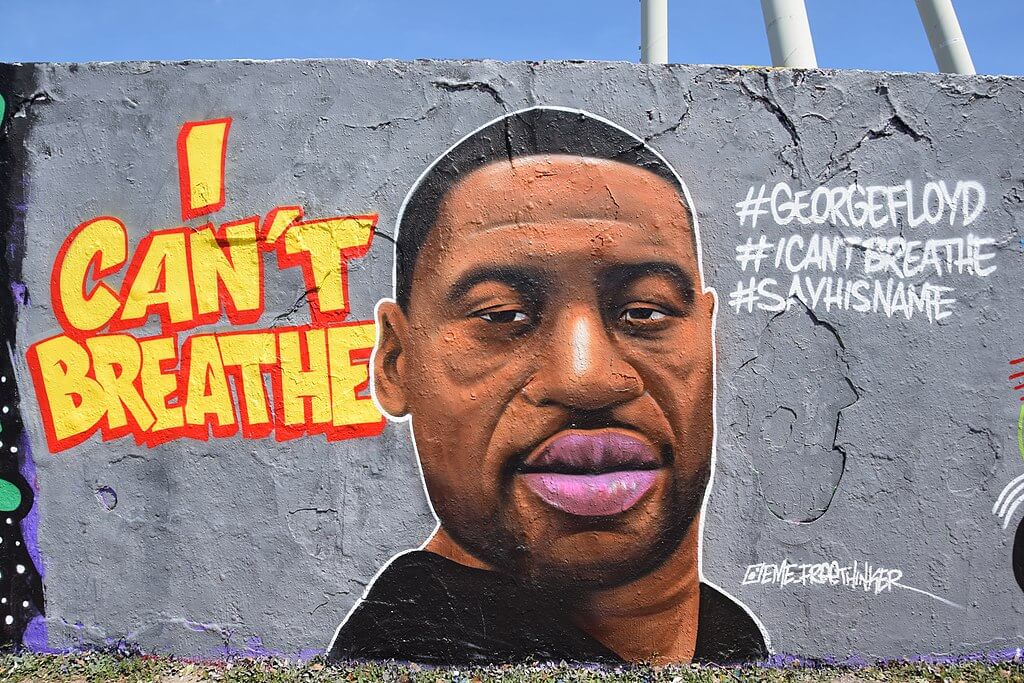
Mural by Dominican graffiti artist Jesus Cruz Artiles – Abdulhamid Hosbas/Anadolu Agency via Getty Images.
Consequently, enraged citizens poured into Minneapolis streets with protest marches. In a heavy-handed and insensitive reaction, the state of Minnesota avoided simply admitting to the unlawful police killing of a Black person. Instead, police abused journalists on live TV in unprecedented scenes of authorities violating the first amendment’s sacred freedom of the press. As protests continued unabated, President Trump tweeted an ominous message on June 2: he would call in the military to quell protesters, whom he promptly termed “terrorists” to legitimize his unconstitutional act. But within days, the military showed that it was loyal to the Constitution over the president. “We have a constitution. We have to follow that constitution. And the president’s drifted away from it,” said former chief of joint staff Colin Powell.
The protesters in Minneapolis were joined by big and small cities nationwide as thousands marched in the streets calling for justice. But in Minneapolis and elsewhere, violence abounded. The long-standing, unheard grievances of the African American community and its marginalization amid COVID-19 converged on the streets. Peaceful protests turned into uprisings as some protesters began breaking into major retailers, looting goods and burning businesses. Minneapolis continued to burn as protesters threw stones, bottles, and other objects at disposal over police vehicles and station buildings. On May 29, a night of chaos unfolded in Minneapolis as protesters set fire to another police station. This precinct was so far the third besieged by protesters.
Minneapolis police fired back tear gas and rubber bullets. The stand-off between police and protesting residents kept growing as officials deployed the National Guard. Protests in other major cities like Chicago, New York and Los Angeles by and large remained peaceful.
Streets across America resounded with the same slogan: “Justice for George Floyd.” Protesters demanded that the four officers involved in Floyd’s death be held fully accountable for their brutality. Derek Chauvin, who suffocated Floyd, faces second degree murder and the other three officers, previously uncharged, now face charges of aiding and abetting murder.[iv]
Minneapolis residents, especially Black Americans, are all too familiar with police brutality. The city has a history of state-led violence and protests. In 2015, two Minneapolis police officers got away with the shooting and killing of Jamar Clark, a 24-year-old Black man. In 2016, police killed Philando Castile, a 32-year-old Black man in Falcon Heights. This encounter circulated on social media for days and months, but still a jury acquitted the officer who killed Castile. Racial discrimination pervades cases involving the Minneapolis police department. Further evidence is the Black Minneapolis officer who killed a 40-year-old white woman in 2017 and who is currently serving a sentence in prison.
Protests continued escalating as the Trump administration’s communication reeked of double standards. In recent weeks, armed white protesters have been flouting stay-at-home regulations. These protesters even forced one capitol to close, and brazenly threatened state officials. Trump did not condemn them but lent support. After a demonstration in Michigan, Trump announced on Twitter: “These are very good people, but they are angry. They want their lives back again, safely!”
Conversely, after the Minneapolis protests, Trump proclaimed, “when the looting starts, the shooting starts.” This statement, widely criticized, angered protesters even more and protests have continued since.[v]
Floyd’s killing also triggered the anger of the disadvantaged at the structural exclusion and neglect of the Black population in the United States. The private healthcare system excludes a large number of African American families, and their lack of entitlements, especially livelihoods, have made them suffer disproportionately from the coronavirus pandemic. Yet many U.S. states are reopening, ignoring how that would worsen the pandemic’s impact on Black communities.
The statistics are alarming. For instance, in Milwaukee County, while African Americans make up 27% of the population, they account for over half of COVID-19 victims. In Illinois, 33% of cases and 40% of COVID-19 deaths are of African Americans, who total merely 15% of the total state population. This becomes even worse in Georgia, where 62% of COVID-19 cases are from the Black population, which is only 37% of the total. In the City of St. Louis, African Americans comprise 47% of the population, but 75% of COVID-19 cases. Similar to the United Kingdom, Black communities in the U.S. have been the worst hit by the COVID-19 pandemic.[vi]
International Solidarity
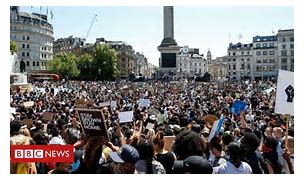 The protests in the U.S. have also resulted in global mobilizations against racism, injustice and inequalities of the capitalist order that devalues and undermines Black lives. June 6 witnessed one of the largest acts of international solidarity since the death of Floyd, with massive protests in Australia, Asia, Europe and across the U.S. In Hong Kong, Spain, Italy and the U.K., citizens held demonstrations against police brutality and racism. Thousands of peaceful protesters across the U.S. continued to rally and multiple police departments announced investigations and arrests tied to allegations of officer misconduct. Anti-racism protesters in the southwest-England port city of Bristol toppled the statue of a prominent slave trader and dumped it into the harbor. In a similar incident, U.S. demonstrators knocked down a statue of Confederate General Williams Carter Wickham. Protesters across the U.S. briefly stopped traffic when they marched across the Golden Gate Bridge in San Francisco, covered miles of highway near the LOVE statue in Philadelphia, and chanted “Revolution, nothing less!” on Los Angeles’s Hollywood Boulevard.[vii]
The protests in the U.S. have also resulted in global mobilizations against racism, injustice and inequalities of the capitalist order that devalues and undermines Black lives. June 6 witnessed one of the largest acts of international solidarity since the death of Floyd, with massive protests in Australia, Asia, Europe and across the U.S. In Hong Kong, Spain, Italy and the U.K., citizens held demonstrations against police brutality and racism. Thousands of peaceful protesters across the U.S. continued to rally and multiple police departments announced investigations and arrests tied to allegations of officer misconduct. Anti-racism protesters in the southwest-England port city of Bristol toppled the statue of a prominent slave trader and dumped it into the harbor. In a similar incident, U.S. demonstrators knocked down a statue of Confederate General Williams Carter Wickham. Protesters across the U.S. briefly stopped traffic when they marched across the Golden Gate Bridge in San Francisco, covered miles of highway near the LOVE statue in Philadelphia, and chanted “Revolution, nothing less!” on Los Angeles’s Hollywood Boulevard.[vii]
The reaction of the U.S. administration, as noted earlier, has also been extraordinary. USA TODAY’s Christine Brennan[viii] called this a “watershed moment”[ix] analyzing government reactions. Thousands of multiracial protesters from all walks of life poured into U.S. capital Washington DC, with the city’s Mayor, Muriel Bowser, joining the crowd outside the White House. She demanded that President Donald Trump withdraw military and federal law enforcement from the city. Trump spent the day inside the White House and made no public appearances. He later ordered the withdrawal of National Guard troops from the streets of Washington.
Americans’ perception of police has dropped by double digits in just one week, as police continue to target peaceful protesters, bystanders and even journalists amid nationwide demonstrations focusing on systemic racism facing African Americans. Two now suspended Buffalo, New York, police officers were charged with second-degree assault on June 6 amid outcry over a video that showed them shoving a 75-year-old man to the ground as they cleared an area of demonstrators. Minneapolis officials voted on June 5 to enact the first changes to the police department since Floyd was killed on Memorial Day.
A History of Racism, Police Killings, and Uprisings[x]
The uprisings that have drawn global attention are neither new nor isolated. They are embedded in the history of United States. Exploitation and brutal maltreatment of Blacks is centuries old, back to the 1739 Stono Rebellion. In 1619, the first slave ship landed in America, laying the foundation of the slave industry that was regulated through Slave Codes. Slave patrols were set up for enforcement, often with brutal force. Some patrolling practices included stopping Black people, searching their homes, and whipping. The former two exist even today. In addition, the notoriously draconian Fugitive Slave Laws of 1793 deprived Africans of basic rights, upholding their inferiority and reiterating white supremacy. In the early 1800s, many Southern states enhanced slave patrols’ authority. In 1864, slave patrols were disbanded, and slavery was abolished with the 13th Amendment. But the Slave Codes remained intact as southern states sought to protect their way of life. The codes were abolished only to be replaced by Jim Crow laws that institutionalized segregation of Blacks until the 1960s.
After slave patrols had ended, police departments emerged in urban areas. By 1858, they became armed[xi] units to protect the interests of the wealthy and keep slaves in check. This is why over-policing in Black-majority communities is common today: law enforcement agencies’ profiling based on race and ethnicity also dates back to that era.
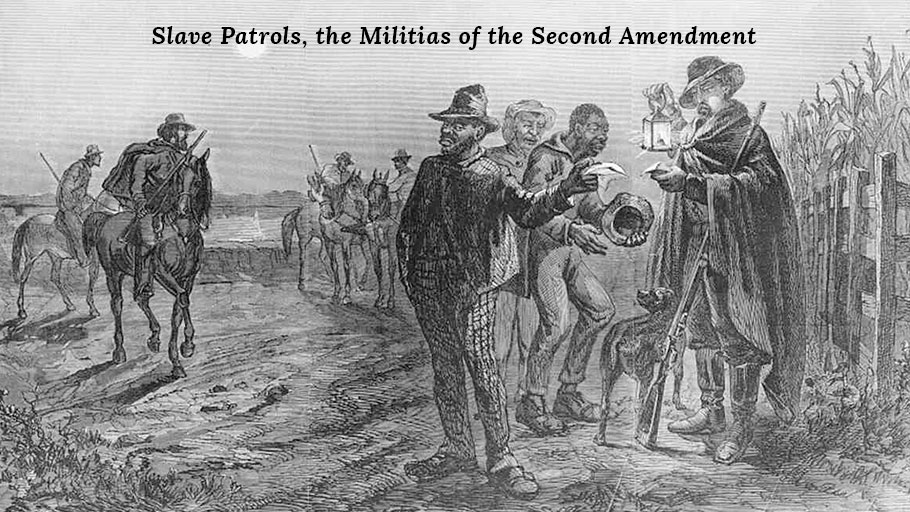
In the twentieth century, after the assassination of Martin Luther King, Jr., Black protests and uprisings took place in more than 125 cities, resulting in dozens of deaths and thousands of arrests. During 1968–72, “at least 960 segregated Black communities witnessed 2,310 separate incidents of what journalists and state security officials described as ‘disturbances,’ ‘uprisings,’ ‘rebellions,’ ‘melees,’ ‘eruptions,’ or ‘riots.’”[xii] Since the enactment of the Civil Rights Act of 1964, Black protests have been treated as a criminal problem, leading to President Lyndon Johnson’s Omnibus Crime Control and Safe Streets Act of 1968, which incentivized increased local policing and surveillance of Black urban areas deemed “vulnerable to rebellion,” as well as formal “riot control” training.
By allocating an unprecedented $330 million to crime response, the federal government began militarizing police departments with surplus weapons from Vietnam. This Safe Streets act enabled small police departments, especially those in cities with many Black residents, to put down uprisings before they generated national media or activist attention.[xiii]
The expansion of digital media in recent years has brought the deaths of police victims such as Mike Brown, Alton Sterling, Eric Garner, Freddie Grey and many more to the limelight. The “No Justice No Peace,” “I Can’t Breathe” and “Black Lives Matter” movements are products of police abuse of power towards mostly unarmed victims.
According to Michael Robinson, a professor at University of Georgia, “current policing tactics are not a new phenomenon but a thinly veiled reflection of policing of the past. Social media has thrust these unjust actions into mainstream America and now Americans are forced to deal with this growing social problem.”[xiv] Why is the past so important and why has the United States not confronted it? A simple answer to this complex question is that structural racism defines even 21st century policy: an edifice built on slavery and violence.
Even though the police shoot white men, African Americans are killed at higher per capita rates. Studies and official reports have time and again shown the police unable to check their conduct when it comes to Black bodies. Police officials are also trained for decades that Black people commit the most crimes in various communities, so Black people are too often designated “suspect.” Stop-and-frisk has always worked around this assumption, as checking Black males between the ages of 14 and 21 has been a cornerstone of this policy.
Journalists and researchers have thoroughly documented this racialized policing system, as demonstrated by Pew Research Center’s survey findings[xv] from the past few years about the intersection of race and law enforcement. The startling results point to a widespread acknowledgment of the problem alongside a deep distrust between the police and Black communities.
In a 2019 survey, 84% of Black adults said that, in dealing with police, Blacks are generally treated less fairly than whites; 63% of whites said the same. Similarly, 87% of Blacks and 61% of whites said the U.S. criminal justice system treats Black people less fairly. Black adults are about five times as likely as whites to say they’ve been unfairly stopped by police because of their race or ethnicity (44% vs. 9%), according to the same survey.
Nearly two-thirds of Black adults (65%) say they’ve been in situations where people acted as if they were suspicious of them because of their race or ethnicity, while only a quarter of white adults say that has happened to them. White police officers and their Black colleagues have starkly different views on fundamental questions regarding the situation of blacks in American society, the 2016 survey found. For example, nearly all white officers (92%) – but only 29% of their black colleagues – said the U.S. had made the changes needed to assure equal rights for Blacks. According to Pew, around “two-thirds of police officers (68%) said in 2016 that the demonstrations over the deaths of Black people during encounters with law enforcement were motivated to a great extent by anti-police bias.”[xvi]
There is political polarization at work, too. “White Democrats and white Republicans have vastly different views of how black people are treated by police and the wider justice system. Overwhelming majorities of white Democrats say Black people are treated less fairly than whites by the police (88%) and the criminal justice system (86%), according to the 2019 poll. About four-in-ten white Republicans agree (43% and 39%, respectively).”[xvii]
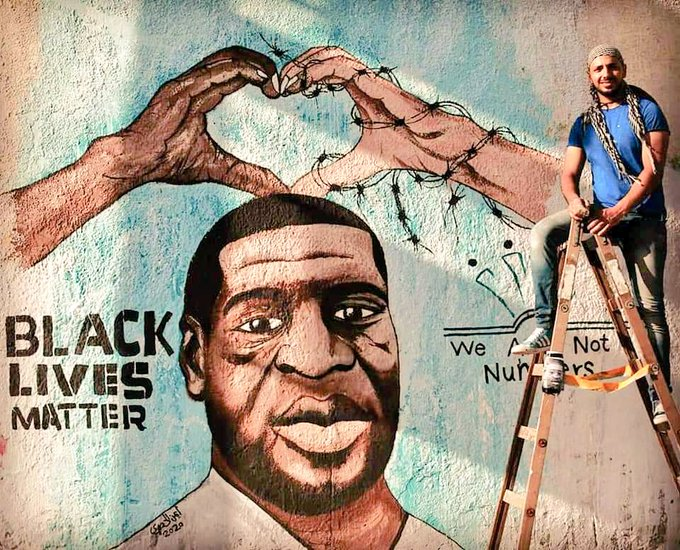
Gaza Artist Ayman Al Hossary via ME Monitor
Violence Against Media
The protests have also affected press freedoms in the United States, with President Trump’s consistent attacks on the press alarming observers. According to Katie Scofield,[xviii] democracies slide into modern authoritarianism with constraints on press freedom and attacks on opposition leaders, followed by a slow corruption of the law. Americans’ confidence in Trump, despite repeated fact check reports highlighting his lies, reveals how oblivious his supporters are. Trump and some Republicans regard media as the “Enemy of State”[xix] while ignoring recent police violence against the press.
COVID-19 has become an instrument to tighten the sphere of dissent. The recent state-sanctioned police brutality and usage of pellet guns outside the White House on peaceful protesters is evidence that Trump’s verbal attacks on journalists have become violent in practice[xx] to further consolidate power. Trump openly wared to use “the unlimited power of our Military and many arrests,” and while this did not go a long way, many analysts have expressed anxiety about the kind of polity Trumpian policies might create.
Implications for US Society and Politics
In recent months, the fault lines within the U.S. have been laid bare: police brutality, the COVID-19 pandemic, the armed claims of individual sovereignty and a dysfunctional political system.[xxi] The Economist Intelligence Unit labelled the U.S. a “flawed democracy” in 2017. But this is not just the fault of Trump and his policies. Inequities, voter suppression and an imperfect healthcare system had undermined the citizen-state relationship already.
Just before the uprisings, President Trump cut ties with the World Health Organization. While U.S. politicians and media criticize China for censorship and violation of human rights in Hong Kong, the scenes from American streets have shocked many leaders and citizens across the globe. This has implications for the U.S.’s standing as a global power.[xxii]
In a recent poll,[xxiii] President Trump was 7.8 percentage points behind former Vice President Joe Biden. Axios, an independent publication, said his numbers had “turned from mixed to bleak.” Axios also reported that many senior Republicans say Trump’s “handling of the nation’s civil unrest, including his hasty photo op at St. John’s Church after the violent clearing of Lafayette Park, make them much more worried about his chance of re-election…”[xxiv]
Trump’s image also suffered when Defense Secretary Mark Esper refused to use active-duty troops against protesters and his predecessor, James Mattis, denounced Trump as a divisive violator who must be held to account.[xxv] Mattis further said Trump made a “mockery of the constitution” by ordering Lafayette Park cleared in an “abuse of executive power.”
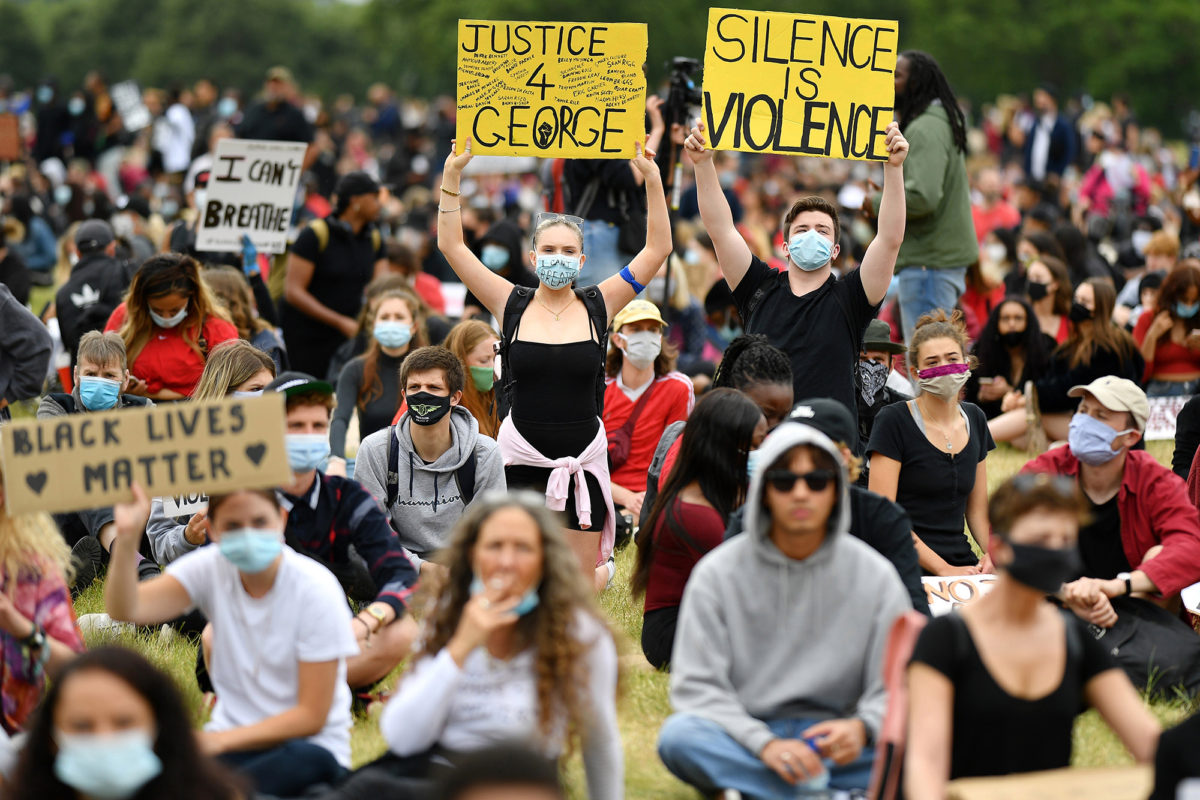
Photo by Justin Setterfield/Getty Images
This is why Trump’s strategy is to focus on his core base of supporters in the next five months, using political rhetoric that will keep them engaged. A Politico article summarized it the best: “The base-only strategy is a gamble for Trump, whose campaign spent much of the past year trying to build up good will with suburban swing voters — knowing their disapproval alone could cost him re-election. But the base is also his safe space.”[xxvi]
In this roiling political atmosphere, if police violence and the deep-seated structures of exclusion are not addressed, Republicans will face greater resentment from a broad base of Americans.
Fixing Police and Systemic Racism
The recent crisis[xxvii] arising from the U.S. government’s heavy hand against peaceful protesters prompted legislator Ilham Omar’s to announce her intention to introduce a legislative package aimed at overhauling the nation’s criminal justice system.
“If we are to change this pattern of violent racism, we need to fundamentally restructure our criminal justice system—and our treatment of those advocating for their rights,” Omar tweeted.[xxviii] The proposed legislation seeks to “provide overarching support for the victims of longstanding and ongoing police violence.” The legal cover would offer solutions for institutional racism of the kind recent U.S. police actions have made hyper-visible. Racism is an institutional and structural problem—not an issue of what small groups of police do, but an underlying and persistent system of racial profiling.
Ilhan Omar and other legislators from both parties believe the systemic scope of U.S. racism demands a systemic solution. Both major parties have drafted competing bills. While these differ in substance, both focus on improved data collection among police agencies, “training for law enforcement officials and incentives for law enforcement officers to wear body cameras.” Most significantly, the bills treat lynching as a federal crime.[xxix]
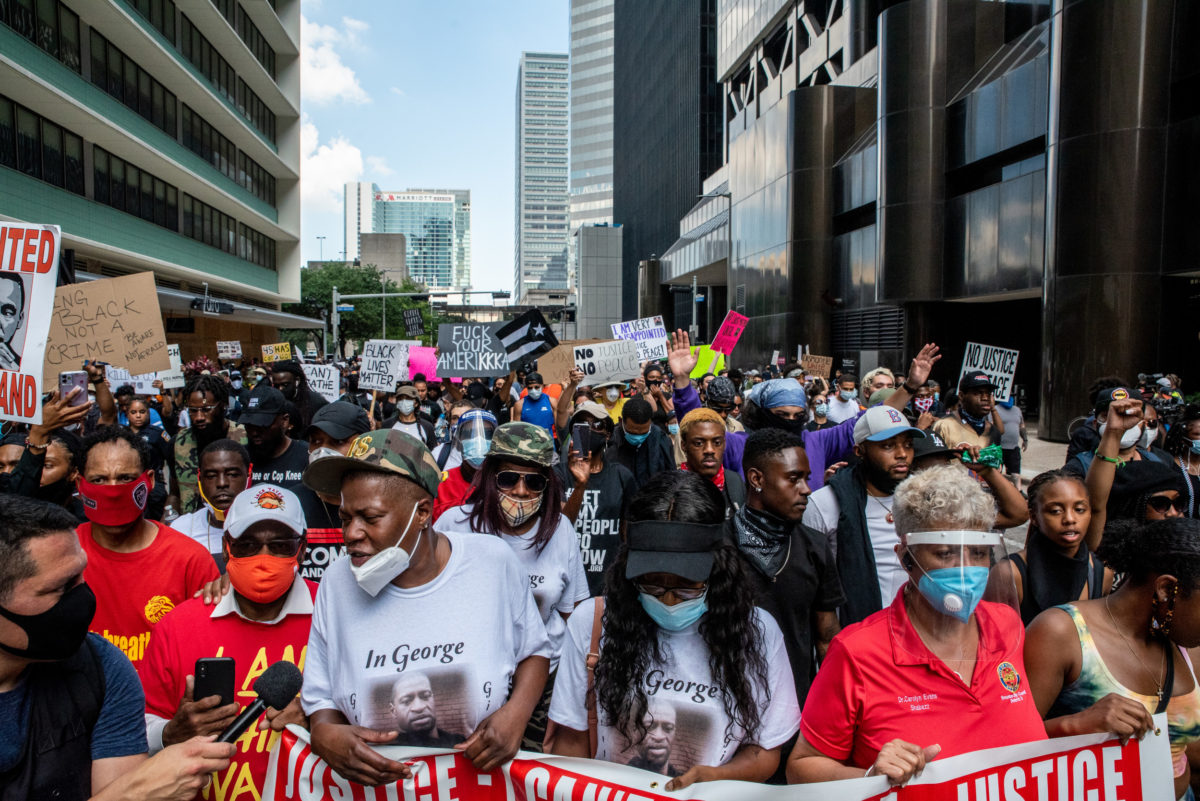
Photo: Sergio Flores/Getty Images
The American Civil Liberties Union (ACLU), along with protesters from Washington DC and Maryland, have decided to sue the President and his administration.[xxx] The lawsuit states that federal forces had “no legitimate basis to destroy the peaceful gathering” in Lafayette Park. President Trump, Attorney General William Barr and other federal officials were named as defendants in the lawsuit, which calls for holding the responsible accountable so that such actions[xxxi] can be prevented in the future and Americans’ rights preserved — including the right to dissent and protest.
The militarization and bigotry in policing, both at the executive and individual level, requires “monumental” reform, and if not, reconstruction. Author and former New York Police Department commander Corey Pegues says, “If police departments around the country were up to the task, there wouldn’t have been another ‘I can’t breathe’ police murder.” Pegues calls for personal liability for police officers and “fixing or breaking up police culture as we currently know it.”[xxxii]
Dozens of writers and scholars, whose perspectives Politico gathered, discussed whether these protests are proving distinct from those of both recent and distant years. While they offer differing perspectives concerning the use of violence and prospects of meaningful police change, firm consensus emerges surrounding two points: First, that the coronavirus pandemic has highlighted racial disparities in employment and healthcare, both drawing mainstream attention and magnifying the suffering of Black Americans in response to police killings. And that police have always been unjustly and brutally killing Black people. But the digital age, especially with the pandemic extinguishing distractions, has made citizen-recorded videos of Black executions almost unignorable to once apathetic masses.[xxxiii]
While the magnitude of mobilization sparks hope for change, it also comes fraught with violence and insufficient leadership. Racial justice has become politically polarized, embodied on the streets as protesters are pitted against police along party lines. But the mass outrage at police killings demands a recognition of humanity that Harvard Sociology professor Lawrence D. Bobo considers absent in George Floyd’s murderers’ casual demeanor. Bobo cites the social conformity and deference prevalent in law enforcement as contributing to the image of police dominating, rather than intervening for and supporting, their communities.[xxxiv]
The recent uprisings are a reminder of the U.S.’s horrendous legacy of racism and exclusion. An adequate answer to them requires policy measures such as addressing mass unemployment, upgrading public schools and an end to discriminatory and segregated housing conditions for Black Americans.
Policymakers in the past have framed inequality as a law and order issue. Richard Nixon’s War on Crime, his later War on Drugs and now President Trump’s emphasis on “Law and Order” all attempt to bypass long-standing disparities with excessive policing, surveillance, and mass incarceration. The time has come for this cycle to change. How long these protests sustain the public debate depends on how myriad social movements organize and influence mainstream parties, especially the Democrats, in coming months.
***** [i] The author is Director, Park Center for Independent Media, Ithaca College; Visiting Faculty Cornell Institute for Public Affairs and founding editor of Nayadaur Media. The author is grateful to Jeremy Lovelett for edits and additions. [ii] Conley, Julia. “As Americans Rise Up Against Racial Injustice, International Crisis Group Calls on Trump to 'Stop Making Situation Worse”. Common Dreams. June 4, 2020. https://www.commondreams.org/news/2020/06/04/americans-rise-against-racial-injustice-international-crisis-group-calls-trump-stop [iii] Ibid. [iv] "George Floyd death: New charges for all four sacked officers." BBC News. June 3, 2020. https://www.bbc.com/news/world-us-canada-52915019 [v] Rogers, Melvin. "We Should Be Afraid, But Not of Protesters." Boston Review. May 30, 2020. https://bostonreview.net/race/melvin-rogers-we-should-be-afraid-not-protesters [vi] Gordon, Colin et al. "COVID-19 and the Color Line." Boston Review. May 1, 2020. http://bostonreview.net/race/colin-gordon-walter-johnson-jason-q-purnell-jamala-rogers-covid-19-and-color-line [vii] Nguyen, Daisy, and Don Thompson. "Crowd clogs Golden Gate Bridge amid marches for George Floyd." ABC News. June 6, 2020. https://abcnews.go.com/amp/Politics/wireStory/large-crowds-march-california-george-floyd-71113922 [viii] Brennan, Christine. “Opinion: If Roger Goodell, league follow through on words, this is a watershed moment for NFL.” USA TODAY. June 5, 2020. https://www.usatoday.com/story/sports/columnist/brennan/2020/06/05/roger-goodell-social-justice-video-nfl-history/3161652001/ [ix] Facing pressure from players, NFLC commissioner Roger Goodell said he wants to do his part to fight against racism and systematic oppression. [x] Robinson, Michael A. "From the Slave Codes to Mike Brown: the brutal history of African Americans and law enforcement." United States Politics and Policy. October 5, 2017. https://blogs.lse.ac.uk/usappblog/2017/10/05/from-the-slave-codes-to-mike-brown-the-brutal-history-of-african-americans-and-law-enforcement/ [xi] A New York City policeman (carrying an unauthorized pistol) shot and killed an unarmed Irish immigrant who posed no threat as he ran away from the policeman. Similar to recent incidents, the policeman was exonerated from any wrongdoing despite public outcry. A similar incident also occurred in Boston. [xii] Hinton, Elizabeth. "The Minneapolis Uprising in Context." Boston Review. May 29, 2020. https://bostonreview.net/race/elizabeth-hinton-minneapolis-uprising-context [xiii] Ibid. [xiv] Robinson, Michael A. "From the Slave Codes to Mike Brown: the brutal history of African Americans and law enforcement." United States Politics and Policy. October 5, 2017. https://blogs.lse.ac.uk/usappblog/2017/10/05/from-the-slave-codes-to-mike-brown-the-brutal-history-of-african-americans-and-law-enforcement/ [xv] Horowitz, Juliana Menasce, Anna Brown, and Kiana Cox "Race in America 2019." Pew Research Center. April 9, 2020. https://www.pewsocialtrends.org/2019/04/09/race-in-america-2019/#majorities-of-black-and-white-adults-say-blacks-are-treated-less-fairly-than-whites-in-dealing-with-police-and-by-the-criminal-justice-system [xvi] Desilver, Drew, Michael Lipka, and Dalia Fahmy. "10 things we know about race and policing in the U.S." Pew Research Center. June 3, 2020. https://www.pewresearch.org/fact-tank/2020/06/03/10-things-we-know-about-race-and-policing-in-the-u-s/ [xvii] Horowitz, Juliana Menasce, Anna Brown, and Kiana Cox. "Views of racial inequality." Pew Research Center. April 9, 2020. https://www.pewsocialtrends.org/2019/04/09/views-of-racial-inequality/#most-agree-blacks-are-treated-less-fairly-than-whites-by-police-and-justice-system [xviii] Scofield, Katie. “Trump’s Military Response to Protests Highlights His Authoritarianism.” Truthout. June 3, 2020. https://truthout.org/articles/trumps-military-response-to-protests-highlights-his-authoritarianism/ [xix] “Media is the cancer; there is no pandemic; states should open; our constitutional rights are being violated, etc.” such have been slogans and statements from pro-Trump protesters who gained his support in several speeches and tweets. [xx] Trump told state governors that they “must establish an overwhelming law enforcement presence until the violence has been quelled.” He then threatened to send in military troops — without governors’ consent — if they did not. [xxi] Rogers, Melvin. "We Should Be Afraid, But Not of Protesters." Boston Review. May 30, 2020. https://bostonreview.net/race/melvin-rogers-we-should-be-afraid-not-protesters [xxii] Sweeney, Pete. "Breakingviews - Protests may be last straw for U.S. global stature." Reuters. June 1, 2020. https://www.reuters.com/article/us-minneapolis-police-protests-breakingv/breakingviews-protests-may-be-last-straw-for-u-s-global-stature-idUSKBN2381CM?utm_medium=Social&utm_source=twitter [xxiii] "General Election: Trump vs. Biden." Real Clear Politics. https://www.realclearpolitics.com/epolls/2020/president/us/general_election_trump_vs_biden-6247.html [xxiv] "Top Republicans are reportedly getting very worried about Trump's re-election odds." The Week. June 4, 2020. https://theweek.com/speedreads/918128/republicans-are-reportedly-getting-worried-about-trumps-reelection-odds [xxv] Goldberg, Jeffrey. "James Mattis Denounces President Trump, Describes Him as a Threat to the Constitution." The Atlantic. June 3, 2020. https://www.theatlantic.com/politics/archive/2020/06/james-mattis-denounces-trump-protests-militarization/612640/ [xxvi] Orr, Gabby. "Trump defaults to his safe space: Energizing the MAGA base." Politico. June 4, 2020. https://www.politico.com/news/2020/06/04/trump-base-2020-maga-299362 [xxvii] The nationwide uprising was sparked by the murder of George Floyd by four Minneapolis police officers. [xxviii] Higgins, Eoin. “Ilhan Omar Criminal Justice Reform Bills Offer 'Systemic Solutions to Systemic Problems.” Common Dreams. June 4, 2020. https://www.commondreams.org/news/2020/06/04/ilhan-omar-criminal-justice-reform-bills-offer-systemic-solutions-systemic-problems [xxix] Cochrane, Emily, and Luke Broadwater. “Here Are the Differences Between the Senate and House Bills to Overhaul Policing.” New York Times. June 17, 2020. https://www.nytimes.com/2020/06/17/us/politics/police-reform-bill.html [xxx] “ACLU, protesters sue Trump over use of force on peaceful demonstrators.” The Week. June 4, 2020. https://theweek.com/speedreads/918360/aclu-protesters-sue-trump-over-use-force-peaceful-demonstrators [xxxi] Security personnel used tear gas and rubber bullets to disperse the crowd, which was protesting the death of George Floyd. This happened shortly before Trump walked over to take photos in front of St. John's Church. [xxxii] Politico Magazine. “It Really Is Different This Time.” Politico. June 4, 2020. https://www.politico.com/news/magazine/2020/06/04/protest-different-299050 [xxxiii] Ibid. [xxxiv] Pazzanese, Christina. “The fire this time.” The Harvard Gazette. June 2, 2020. https://news.harvard.edu/gazette/story/2020/06/lawrence-d-bobo-examines-police-killings-of-black-men/

